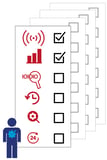What is Demand Capacity Planning?
Brian Hoey - April 10, 2018

Imagine you’re at the grocery buying cooking supplies for the coming week. You see that tomatoes are on sale if you buy them in quantities of ten. Hoping to make use of the savings, you do some quick calculations in your head: the ripe tomatoes will remain fresh for about a week; you cook roughly one meal a day; your favorite dish requires two tomatoes. You determine that you could easily utilize ten tomatoes before they go bad, but you would have to commit to making the same dish five nights out of seven, and you might not be in the mood for it later in the week.
In our grocery store hypothetical, you’ve just engaged in some rudimentary demand capacity planning. Of course, in this instance demand simply meant your desire or willingness to cook and eat certain foods, rather than the nuances and complexities that impact variant-rich industries like manufacturing or freight forwarding, but the basic principal remains the same: how can I minimize the discrepancy between production capacity and real demand in the form of orders?
While in the case of the tomatoes this balance can be achieved with little more than some back of the envelope math and a willingness to eat your vegetables, mounting complexities in terms of production and supply streams mean that real-life demand capacity planning can present a difficult challenge for many supply chain managers. Historically, planners have had to rely on past demand to shape their views of future necessities, but this can often lead to bottlenecks and disruptions, in which capacity goes under-utilized, or production and shipping processes are unable to meet demand. Luckily, a robust demand capacity planning workflow can help to mitigate the potential ill-effects of an operational gap between demand and actual capacity.
Demand Forecasting and Predictive Analytics
One of the most powerful components of demand capacity planning when it comes to simplifying supply chain logistics is its ability to integrate smarter forecasting and predictive analytics into the planning process. Where earlier eras required planners to rely solely on past demand to plan for future production needs, modern predictive analytics empowers businesses to tailor their production plans to potentially more accurate forecasts that account for numerous variables and modalities. In terms of capacity planning, this means that machine- and person-hours can be utilized in a way that maximizes the output of the parts and products for which there are going to be large orders, while minimizing the production of items that will sit unsold and take up inventory space.
By the same token, shippers and freight forwarders can use this same mentality to cut through the tremendous complexity involved in getting the right product to the right place at the right time in a way that optimizes truck and container usage. The decision to send a less than full truckload or wait for added orders can be informed with more complete information about the entire value stream. The result is a more efficient use of resources that turns predictive workflows into meaningful value-added opportunities.
Enhanced Production Visibility
Demand capacity management revolves around the idea that the right resources can and should be utilized in the right way at the right time to better align real and expected demand with a given business’s throughput. In order to determine what the right resources, places, and times are, however, companies need a clear, holistic picture of their actual resource usage and general capacity. In this way, demand capacity management solutions can actually drive an increased level of end-to-end (E2E) visibility across all touch points on their respective supply chains. Production plans and freight utilization can be managed more intelligently, owing to a higher degree of transparency in terms of the exact relationships between various workflows and overall production economy.
Improved Inventory Management
Optimizing the relationship between real demand and capacity utilization can help promote smarter supply chain logistics, ultimately reducing waste, helping to stave off bottlenecks, and saving time and money. Effective demand capacity management can, however, interact in a synergistic manner with related operational processes. To take a representative example, inventory management can be made more efficient by better aligning demand and capacity utilization. If more accurate demand forecasts can prevent the buildup of excess stock, for instance, the logistical hurdles and costs associated with storing that excess stock can be largely eliminated, saving money and streamlining the entire inventory workflow.
If you want to learn more, download your guide to Transformation of Manufacturing Processes.
In this Guide you will learn:
-
Emerging Challenges in the Modern Truck/Automotive Industry
-
How Can Global Companies Adapt to These New Realities
-
How Decentralized Digital Systems Power Smarter Planning Processes
-
How flexis Can Support Flexible Supply Chain Transformation
LATEST POSTS
- Understand Circular Economy in The Manufacturing Industry
- How Can Industry 4.0 IT Integration Be Achieved Smoothly?
- The Significance of Order Sequencing in Discrete Manufacturing
- How to improve your Supply Chain Management: The Power of Control Towers
- Optimizing Human Resource Scheduling in Manufacturing: A Technological Approach



